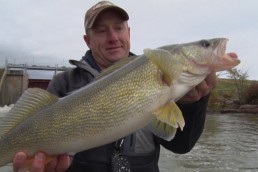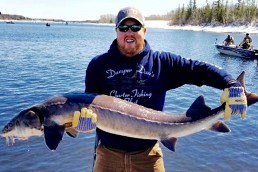Sturgeon Spawning on the Wisconsin River
SHARE THIS POST
I was lucky enough to see the Wisconsin DNR fishery personnel doing their annual sturgeon shocking on the Wisconsin River, below the dam at Wisconsin Dells. The purpose of the spring shocking is to collect eggs and sperm from the mature fish, fertilize the eggs, and transport them back to the Wild Rose Hatchery, where they will be raised before their release as fry and fingerlings.
The lake sturgeon is truly a giant among inland freshwater fishes and a living fossil, having made its first appearance 100,000,000 years ago during the Upper Cretaceous period of the Mesozoic era, just about the time the dinosaurs become extinct. By the middle of the 19th century, the lake sturgeon was considered a nuisance to commercial fishermen. But the value of the eggs or roe (caviar) and the delicious flesh, either fresh or smoked, caused a great and intensive fishing demand. The lake sturgeon has never recovered from overfishing and now is listed as a rare species in the United States. Wisconsin is lucky enough to have a naturally reproducing lake sturgeon population in several of its river system. The Chippewa River, the Menominee River, the Flambeau River, the Yellow River and the Wisconsin River all have good populations of reproducing sturgeon.
The lake sturgeon lives longer and grows larger than any other fish in Wisconsin. Female surgeon live longer than males, with 97 percent of all sturgeon over 30 years old being females. A female sturgeon doesn’t reach sexual maturity till they are 25 years old and about 55 inches long. They, then spawn once every 4 or 5 years. Males are sexually mature at about 13 to 15 years old or when they are about 45 inches long. The males then spawn every two years, or twice as often as females. Early in their lives, lake sturgeon grow more rapidly in length than weight, but this pattern changes as the fish grows older. Growth can depend on several factors, with the most important ones being the availability of food and water temperature.
This is the time of the year when DNR fishery technicians are busy shocking sturgeon around the state. The water temperature must be between 55 and 57 degrees for the sturgeon to spawn. The inconsistent spring weather has had fish waiting to spawn, but the river water has been too cold with the coming of cold fronts every other week.
I watched DNR technicians process the fish that they had electroshocked below the Dells Dam. The DNR staff milked the females for eggs, took sperm in syringes from the males, and mixed the two together for fertilization. A mixture of clay is added to the mixture so that the eggs don’t clump or stick together.
I also learned that there were many different sturgeon strains in the state. There’s the Mississippi-Wisconsin River, the Winnebago-Wolf River, the Flambeau River, the Menominee River, and the Yellow River strain of sturgeon.
The Wisconsin Dells dam has prevented the sturgeon from spreading north to the Wisconsin River. Pollution may also have prevented the northern spread of the lake sturgeon into the upper reaches of the Wisconsin River. But, the Sturgeon Restoration Program has provided sturgeon for stocking in the Wisconsin River above the Dells Dam. All the fry that are raised at the Wild Rose Hatchery from the Wisconsin River are only stocked in the Wisconsin River. This also holds true for all the sturgeon that are collected and raised from other river systems. In other words, each strain stays in their respective rivers,
Are you enjoying this post?
You can be among the first to get the latest info on where to go, what to use and how to use it!
Under ideal conditions, the egg and sperm “cocktail” will hatch fry in 10 to 14 days. In the rivers in ideal conditions, the eggs are laid and fertilized on hard rock bottom locations in water less than 5 feet deep. The fry are then at the river’s mercy and drift downriver with the current. Eventually, as they grow and mature, they settle into areas where they have less current and abundant food for growth. They stay in these rearing areas all summer till they seek out deeper water in the fall.
Alliant Energy is a great partner with the DNR in much of the sturgeon work on the Wisconsin River. Their help and cooperation is necessary and of utmost importance for the sturgeon program to continue to succeed.
Become a MidWest Outdoors Insider here!
MWO
SHARE THIS POST
Did you enjoy this post?
You can be among the first to get the latest info on where to go, what to use and how to use it!
Gary Engberg
If you have any questions or comments you may reach Gary Engberg at 608-795-4208 or garyengbergoutdoors.com.



